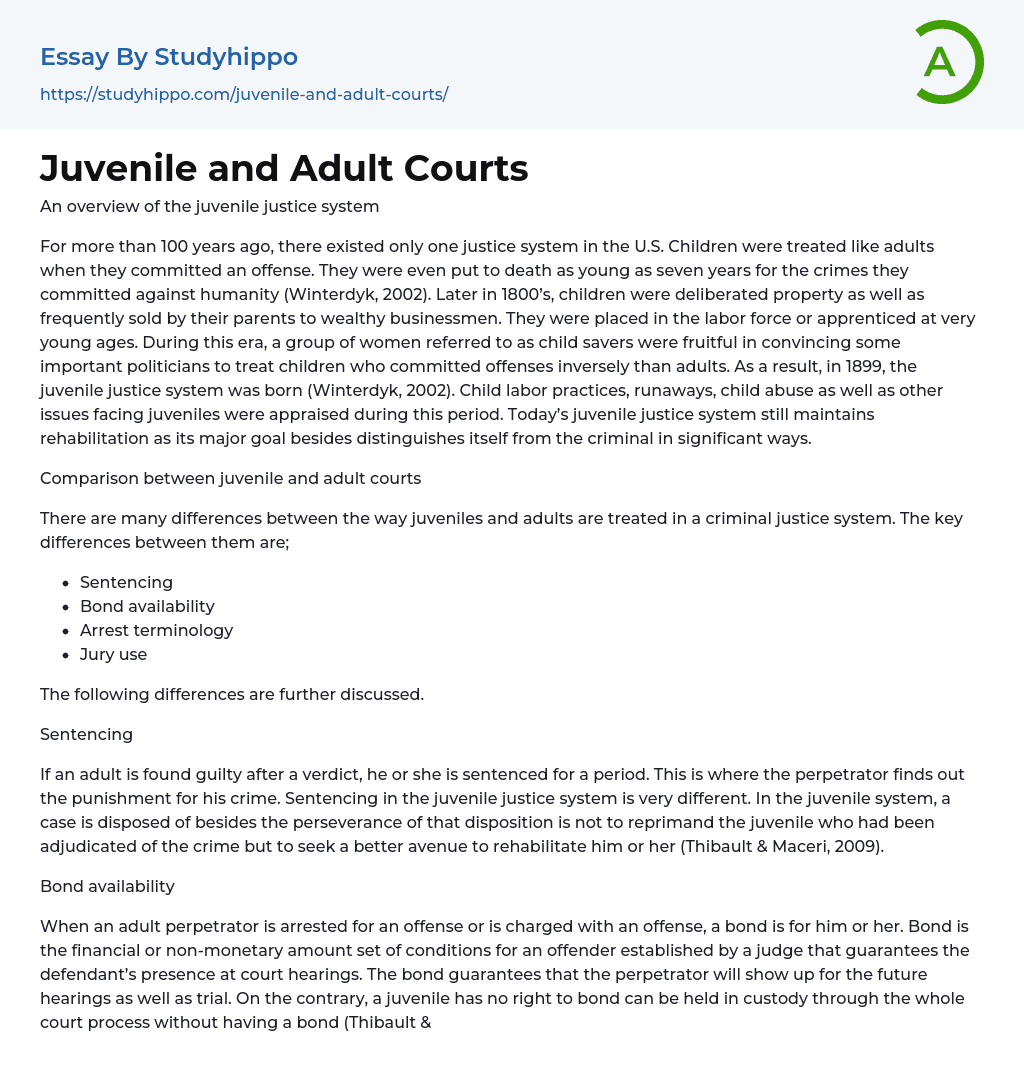An overview of the juvenile justice system
For more than 100 years ago, there existed only one justice system in the U.S. Children were treated like adults when they committed an offense. They were even put to death as young as seven years for the crimes they committed against humanity (Winterdyk, 2002). Later in 1800’s, children were deliberated property as well as frequently sold by their parents to wealthy businessmen. They were placed in the labor force or apprenticed at very young ages. During this era, a group of women referred to as child savers were fruitful in convincing some important politicians to treat children who committed offenses inversely than adults. As a result, in 1899, the juvenile justice system was born (Winterdyk, 2002). Child labor practices, runaways, child abuse as well as other issues facing juveniles were appraised during this period. Today’s juvenile justice system still maint
...ains rehabilitation as its major goal besides distinguishes itself from the criminal in significant ways.
Comparison between juvenile and adult courts
There are many differences between the way juveniles and adults are treated in a criminal justice system. The key differences between them are;
- Sentencing
- Bond availability
- Arrest terminology
- Jury use
The following differences are further discussed.
Sentencing
If an adult is found guilty after a verdict, he or she is sentenced for a period. This is where the perpetrator finds out the punishment for his crime. Sentencing in the juvenile justice system is very different. In the juvenile system, a case is disposed of besides the perseverance of that disposition is not to reprimand the juvenile who had been adjudicated of the crime but to seek a better avenue to rehabilitate him o
her (Thibault & Maceri, 2009).
Bond availability
When an adult perpetrator is arrested for an offense or is charged with an offense, a bond is for him or her. Bond is the financial or non-monetary amount set of conditions for an offender established by a judge that guarantees the defendant’s presence at court hearings. The bond guarantees that the perpetrator will show up for the future hearings as well as trial. On the contrary, a juvenile has no right to bond can be held in custody through the whole court process without having a bond (Thibault & Maceri, 2009). The only exceptional incidence when a juvenile can be permitted the right to bond is if the case was severe enough to be moved into the adult system.
Arrest terminology
When an adult gets into trouble for committing an offense, he or she is arrested or taken out of the public besides put in jail for some period (Winterdyk, 2002). This action brings in a difference between a juvenile and an adult in the kind of words used throughout the operation. In an effort to de-criminalize juvenile actions, the justice system uses diverse words to designate the happenings of the criminal process when it comprises children. For instance, the word arrest is not used in the juvenile justice system, but slightly a juvenile is taken into custody despite the two words having the same meaning.
Jury use
Finally is the difference in the right to a jury. The constitutional gives adults the right to choose a jury to hear their case if it goes to trial. Nonetheless, in most states, children do not have the right to a jury trial unless they
are facing a bind over. A bind over is a proceeding to decide if a juvenile should be tried like an adult in court instead of as a minor. Bind over apply only to severe cases like murder besides most juvenile cases are tried in front of a judge referred to a bench trial (Thibault & Maceri, 2009). At the end of a trial, an adult is either found guilty or not of the crime committed. On the contrary, in the juvenile system, the word used is adjudged and not guilty.
References
- Thibault, E. A., & Maceri, J. J. (2009). Juvenile justice guide. Flushing, NY: Looseleaf Law
Publications. - Winterdyk, J. (2002). Juvenile justice systems: International perspectives. Toronto, Ont:
Canadian Scholars' Press.
- Animal Cruelty essays
- Charles Manson essays
- Crime Prevention essays
- Crime scene essays
- Criminal Justice essays
- Criminology essays
- Cyber Crime essays
- Damages essays
- Detention essays
- Distracted Driving essays
- Drug Trafficking essays
- Drunk Driving essays
- Forensic Science essays
- Gang essays
- Hate Crime essays
- Homicide essays
- Identity Theft essays
- Juvenile Crime essays
- Juvenile Delinquency essays
- Juvenile Justice System essays
- Law Enforcement essays
- Murder essays
- Organized Crime essays
- Penology essays
- Piracy essays
- Prison essays
- Property Crime essays
- Prostitution essays
- Punishment essays
- Punishments essays
- Rape essays
- Robbery essays
- Serial Killer essays
- Sexual Assault essays
- Sexual Assault on College Campuses essays
- Sexual Harassment essays
- Sexual Offence essays
- Stealing essays
- Surveillance essays
- Ted Bundy essays
- Victim essays
- Violent crime essays
- White Collar Crime essays
- Apology essays
- Character Traits essays
- Compassion essays
- Expressive essays
- Perseverance essays




